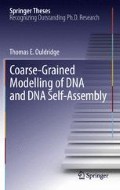Abstract
When this project was started in 2007, very few models were available in the literature. In particular, no thermodynamic simulations of systems involving branched duplexes had been performed. It was therefore necessary to establish whether the aim of simulating nanotechnology with a coarse-grained model was a feasible one.
Access this chapter
Tax calculation will be finalised at checkout
Purchases are for personal use only
Notes
- 1.
In fact, after the model was implemented it was found that \(\cos (\phi _3)=\cos (\phi _4)\), and so the modulation could be simply calculated as \(\cos ^2(\phi _3)\).
- 2.
References
F. W. Starr and F. Sciortino. Model for assembly and gelation of four-armed DNA dendrimers. J. Phys.: Condens. Matter, 18:L347–L353, 2006.
T. E. Ouldridge et al. The self-assembly of DNA Holliday junctions studied with a minimal model. J. Chem. Phys., 130:065101, 2009.
J. Malo, et al. Engineering a 2D protein-DNA crystal. Angew. Chem. Int. Ed., 44:3057–3061, 2005.
J. Bois et al. Topological constraints in nucleic acid hybridization kinetics. Nucl. Acids Res., 33(13):4090–4095, 2005.
S. A. Harris, C. A. Laughton, and T. B. Liverpool. Mapping the phase diagram of the writhe of DNA nanocircles using atomistic molecular dynamics simulations. Nucl. Acids Res., 36(1):21–29, 2008.
F. Ding et al. Ab initio RNA folding by discrete molecular dynamics: From structure prediction to folding mechanisms. RNA, 14:1164–1173, 2008.
E. J. Sambriski, V. Ortiz, and J. J. de Pablo. Sequence effects in the melting and renaturation of short DNA oligonucleotides: structure and mechanistic pathways. J. Phys.: Condens. Matter, 21(034105), 2009.
A. Morriss-Andrews, J. Rottler, and S. S. Plotkin. A systematically coarse-grained model for DNA and its predictions for persistence length, stacking, twist and chirality. J. Chem. Phys., 132:035105, 2010.
S. Whitelam et al. The role of collective motion in examples of coarsening and self-assembly. Soft Matter, 5(6):1521–1262, 2009.
M. Swart et al. \(\pi \)-\(\pi \) stacking tackled with density functional theory. J. Mol. Model., 13(12):1245–1257, 2007.
J. Sponer et al. Nature of base stacking: Reference quantum-chemical stacking energies in ten unique B-DNA base-pair steps. Chem. Eur. J., 12(10):2854–2865, 2006.
J. SantaLucia, Jr. and D. Hicks. The thermodynamics of DNA structural motifs. Annu. Rev. Biophys. Biomol. Struct., 33:415–40, 2004.
N. Peyret. Prediction of nucleic acid hybridization: parameters and algorithms. PhD thesis, Wayne State University, 2000.
D. V. Pyshnyi and E. M. Ivanova. Thermodynamic parameters of coaxial stacking on stacking hybridization of oligodeoxyribonucleotides. Russ. Chem. B+, 51:1145–1155, 2002.
D. V. Pyshnyi and E. M. Ivanova. The influence of nearest neighbors on the efficiency of coaxial stacking at contiguous stacking hybridization of oligodeoxyribonucleotides. Nucleos. Nucleot. Nucl., 23(6–7):1057–1064, 2004.
M. J. Lane et al. The thermodynamic advantage of DNA oligonucleotide ‘stacking hybridization’ reactions: Energetics of a DNA nick. Nucl. Acids Res., 25(3):611–616, 1997.
V. A. Vasiliskov, D. V. Prokopenko, and A. D. Mirzabekov. Parallel multiplex thermodynamic analysis of coaxial base stacking in DNA duplexes by oligodeoxyribonucleotide microchips. Nucl. Acids Res., 29(11):2303–2313, 2001.
S. Woo and P. W. K. Rothemund. Programmable molecular recognition based on the geometry of DNA nanostructures. Nature Chem., 3:620–627, 2011.
J. A. Holbrook et al. Enthalpy and heat capacity changes for formation of an oligomeric DNA duplex: Interpretation in terms of coupled processes of formation and association of single-stranded helices. Biochemistry, 38(26):8409–8422, 1999.
N. Peyret et al. Nearest-neighbour thermodynamics and NMR of DNA sequences with internal AA, CC, GG and TT mismatches. Biochemistry, 38:3468–3477, 1999.
E. Protozanova, P. Yakovchuk, and M. D. Frank-Kamenetskii. Stacked-unstacked equilibrium at the nick site of DNA. J. Mol. Biol., 342(3):775–785, 2004.
P. Yakovchuk, E. Protozanova, and M. D. Frank-Kamenetskii. Base-stacking and base-pairing contributions into thermal stability of the dna double helix. Nucl. Acids Res., 34(2):564–574, 2006.
R. Everaers, S. Kumar, and C. Simm. Unified description of poly- and oligonucleotide DNA melting: Nearest-neighbor, poland-sheraga, and lattice models. Phys. Rev. E, 75:041918, 2007.
W. Saenger. Principles of Nucleic Acid Structure. Springer-Verlag, New York, 1984.
K. M. Guckan et al. Factors contributing to aromatic stacking in water: evaluation in the context of DNA. J. Am. Chem. Soc., 122(10):2213–2222, 2000.
W. B. Sherman and N. C. Seeman. Design of minimally strained nucliec acid nonotubes. Biophys.J.,90(12):4546–4557,2006
Author information
Authors and Affiliations
Rights and permissions
Copyright information
© 2012 Springer-Verlag Berlin Heidelberg
About this chapter
Cite this chapter
Ouldridge, T.E. (2012). A Novel DNA Model. In: Coarse-Grained Modelling of DNA and DNA Self-Assembly. Springer Theses. Springer, Berlin, Heidelberg. https://doi.org/10.1007/978-3-642-30517-7_2
Download citation
DOI: https://doi.org/10.1007/978-3-642-30517-7_2
Published:
Publisher Name: Springer, Berlin, Heidelberg
Print ISBN: 978-3-642-30516-0
Online ISBN: 978-3-642-30517-7
eBook Packages: Physics and AstronomyPhysics and Astronomy (R0)

